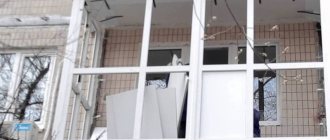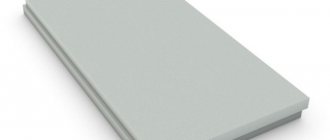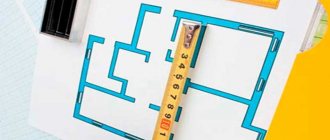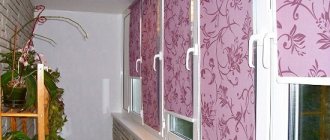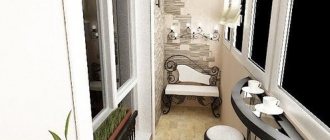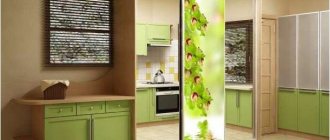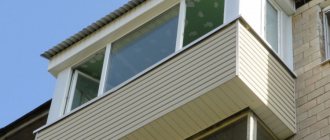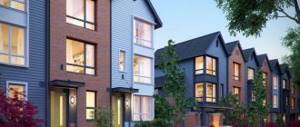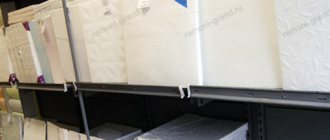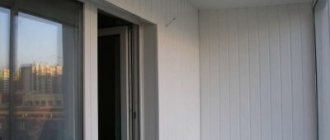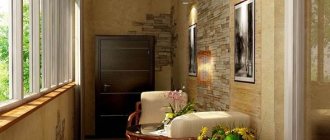Home/Articles/Brick walls on the balcony - options for ideal finishing (77 photos)
Brickwork is a beautiful decorative addition to any living space. High-quality installation allows you to add a unique zest to the interior of the room.
Quite often, a brick wall on a balcony loses its attractiveness over time.
The stone gradually begins to lose its color and salt deposits can be observed on its surface.
Many owners begin to think: “How to paint a brick wall on a balcony?” You will find the answer to this question in our material.
Here you can get acquainted with all the intricacies of the process of painting a brick wall.
Modern methods of painting brick walls
Today, the finishing of a brick balcony is divided into two categories:
- decoration using natural bricks;
- leveling with plaster mixture followed by painting.
The first category of finishing is used only when there are no multiple defects and splinters on the surface. The second method is most relevant for excessive damage that spoils the entire appearance of the wall.
How to paint a brick balcony as a decoration element? Before you begin the work process, it is recommended to follow several steps that will help the paint not crumble from the wall surface:
- stripping;
- alignment of seams between stones;
- priming the wall surface.
First of all, professionals recommend removing the remaining old paint and dust from the wall. If you neglect this requirement, then soon the new paint will begin to crumble, since there will be no tight adhesion to the wall surface.
Finishing a brick balcony requires special efforts that guarantee the desired result. The seams between the brick elements are cleaned with a stiff brush.
After which, the void between the stones is filled with a mixture of mortar using a special spatula. During the filling process, it is important not to stain the brick.
Once the seams have dried, you can proceed to the priming process. Every centimeter of a brick balcony must be carefully primed. After the primer has completely dried, you can proceed to painting the wall.
Finishing the balcony with tiles: reliable and durable!
It has long been known that a balcony is an important part of any apartment. It’s not for nothing that every owner strives to ennoble it. As a rule, finishing of a balcony is carried out at the final stage of its renovation.
There are many building materials that give the balcony room an attractive look. Unfortunately, many of them are afraid of high and low temperatures, absorb moisture, and wear out quickly. Tiles have great advantages.
Let's take a closer look at all the issues related to the use of tiles for the balcony.
Content:
What tiles to lay on the balcony
If we talk about open balconies, then tiles are the best option for finishing. There are many different types of tiles available, but only a few are considered universal for open and closed balconies.
Widespread and affordable material. It cuts easily, but is very fragile. There are tiles of different sizes and qualities on the market. There are samples with high strength and frost resistance, which are used for cladding walls and floors on open balconies.
The material is specially designed for use in harsh conditions with heavy loads. Subsequently, the range of materials was expanded with decorative options. High resistance to abrasion and frost resistance make porcelain stoneware very popular for cladding walls and floors on open balconies. Its important quality is the presence of an anti-slip layer.
The material is made from special types of clay by extrusion (squeezing). There is a wide variety of shapes and colors of such tiles. High wear resistance, frost resistance and anti-slip qualities allow the material to be used on all types of balconies. A surface laid with clinker can be easily cleaned of dirt using available means.
Experts recommend selecting tiles for the balcony floor according to the following criteria:
- Due to the small area of the balcony, small cladding material is needed. A tile measuring 400 by 400 mm would look ideal;
- thin and light tiles will not overload the balcony slab;
- a simple pattern on the cladding with soft colors visually enlarges the balcony, it becomes lighter;
- a material with a wear resistance index of at least 3 is required;
- The laid tiles should not slip.
The requirements for choosing wall tiles are simpler:
- A medium-sized coating will make the wall of a small balcony very attractive. It should match the color and size of the floor tiles;
- light colors of tiles like brick or wood have an advantage;
- for open balconies, the facing material must be resistant to changes in humidity and temperature.
Pros and cons of tiles
Compared to various finishing materials, tiles have a number of advantages that are in demand when tiling a balcony:
- high durability and wear resistance associated with pressing technology and subsequent firing of the source material;
- coating safety. The raw materials consist of natural ingredients that are not hazardous to health. In addition, the coating does not slip thanks to the protective layer on the tile;
- good hygienic qualities. Any tile is easy to clean because it does not absorb dirt, and fungi and mold do not grow on its surface;
- a wide selection of shapes, colors and textures. The building materials market offers a wide variety of tiles designed for use in various conditions.
Preparing the base
Before finishing, you need to level the walls of the balcony. There can be three options:
- The walls of the balcony are smooth with minor defects. You can leave it as is or carry out spot repairs - this will not affect the quality of installation.
- There are medium-sized defects - differences within 1-2 cm, cracks. In this case, it is advisable to level the walls of the loggia with plaster. It is applied to the reinforcing mesh.
- Strong changes, the walls on the balcony are littered. Moisture-resistant drywall will help here. Moreover, you can put insulation under it. But finishing the loggia with artificial stone requires strengthening the wall. Therefore, the distance between the axes of CD profiles is made not 600 mm, but 400 mm. After installation, the slabs must be coated with antifungal impregnation and primer.
READ MORE: Self-waterproofing of balconies and loggias
The wall needs to be plastered along the lines; the finished surface is treated with impregnation and primer.
Sheathing stages
The entire workflow consists of several steps:
- Choice of finish, color and texture of the coating.
- Preparing installation tools and additional consumables.
- Preparing the walls. Stone fragments can only be laid on a flat surface. If there are defects on the walls, they can be corrected using:
- reinforcing mesh and plaster for walls;
- laying moisture-resistant drywall.
The second option is used for deep unevenness and defects.
- Choosing a finishing method. The surface cladding can be done with jointing or seamless.
- Laying the material.
- Grouting joints.
- cement;
- expanded clay;
- sand;
- water-repellent components;
- coloring matter;
- ceramic chips.
After completion of the work, the coating is completely ready for use after 24 hours.
Selection of stone cladding
When planning finishing work on the balcony, you need to determine the type of decorative coating. You can use natural or artificial stone.
Natural coating is often used when finishing houses: it is more durable, but it is also heavy and expensive, so it is not entirely suitable for cladding a regular balcony.
A good alternative to natural stone is artificial material. It is made on the basis of concrete, to which additional ingredients are added:
Artificial turf is environmentally friendly, looks practically no different from natural material, and at the same time has high strength at a low price.
Comparison of characteristics:
- Artificial turf is lightweight and does not require special preparatory work before installation. If natural materials are installed, then it is impossible to do without reinforcing the surface. The total weight of coated walls increases by 2–3 times.
- In terms of strength, artificial material is inferior to natural material, but for interior decoration it has sufficient wear resistance.
- The process of laying natural stone is more complicated. While cladding with artificial elements can be done even with your own hands, it is unlikely that you will be able to create a natural coating without the help of a craftsman.
- The price of artificial material is lower than natural material, which significantly reduces costs.
For the internal cladding of a balcony, artificial stone covering is optimal.
Necessary materials
In order to lay out decorative stone, you will need additional materials:
- Glue . It is best to choose a special adhesive for stone, but adhesive for ceramic tiles also works well. Liquid nails can only be used when covering the surface with gypsum elements, provided that the wall is perfectly flat.
- Water repellent . After its application, the surface stops absorbing moisture. The effect is achieved due to water-repellent compounds in the mixture.
- Grout or paint for joints . Its color matches the shade of the coating.
- Primer mixture for concrete . It improves the adhesion of the glue to the surface.
Installation technology
Decorating a balcony with decorative stone is not much different from installing ceramic tiles - it’s even easier to do.
Step #1. The decorative stone is unpacked, the inside is cleaned of cement deposits. After this, the tiles are laid on the floor. This way you can see the future pattern in advance and eliminate possible color differences.
Step #2. The glue is mixed according to the manufacturer's instructions. For this it is best to use a mixer.
Step #3. The wall and tiles are slightly moistened with water - due to this, the glue will absorb into the surface faster.
Step #4. The glue is applied to the wall with a special notched trowel, the tooth height is 1 cm. The solution is applied to the tile in a thin layer - 4-6 mm.
Step #5. The first row is glued. If installation starts from the bottom, it is advisable to calculate the tiles so that the last row is complete. It is better to do pruning on the first row - it will not be so noticeable. Therefore, the first row does not lie on the floor, but on a guide - this can be a piece of profile or a wooden beam. The main thing is that it is even.
READ MORE: How to remove mold on balconies and loggias
Step #5. After finishing, the glue needs to be given time to dry. It takes 1-2 days.
Step #6. Grout is applied:
- since the seams between the tiles are deep, you will need a special syringe or bag to apply the grout evenly;
- the seams need to be cleaned well;
- the grout is applied as evenly as possible, the gaps are filled completely;
- wait 10-20 minutes, then unstitch the seams.
This completes the finishing of the balcony walls with stone.
Tips for Beginners
In order for the finishing of the balcony to turn out to be of high quality and last a long time, you need to learn how to choose the material. Rules and selection criteria:
- it is necessary to buy finishing coating, as well as additional building materials for its installation, in specialized stores, where the seller can provide documentary evidence of the quality of the product;
- the price of the material depends on its quality, so there is no need to chase the low price of the product;
- Before purchasing, it is good to read the reviews of users who have previously purchased materials from a particular manufacturer.
When performing finishing work, beginners often make a number of mistakes, due to which they are unable to complete the job efficiently. Styling Tips:
- before starting work, it is necessary to mark the surface in order to understand in which places the cladding will be carried out;
- it is necessary to avoid the concentration of elements of large or, conversely, small size, fragments of the same color or height;
- the width of the seams between the elements should not be too large, as this spoils the overall appearance of the interior;
- the surface must be thoroughly primed before laying, otherwise fragments of the masonry may soon fall off the wall;
- pruning must be carried out carefully, since scratches and other defects make the cladding look careless;
- when laying fragments, it is necessary to maintain rows;
- if the grouting material gets on the masonry, it must be removed from the surface before it hardens;
- stones cut off at the top should be mounted above eye level, and fragments with the bottom cut off - below;
- the color of the fragment and texture must be selected taking into account the size of the room, other finishing materials and interior items present in it.
Decorating a balcony with decorative stone is an interesting and practical type of cladding . The design process is simple; you only need a small set of tools and some skills. If you follow the installation rules, you can get the job done quickly, and the result will please you for a long time.
Decorating a balcony with artificial stone is one of the popular types of finishing. Just a few years ago, only fairly wealthy people could afford this decorative element. Nowadays, high technologies are used, which have significantly reduced the cost of production, thereby reducing the price of the final product.
The advantage of finishing with decorative stone
In its composition, artificial decorative stone is quite similar to paving slabs. Decorative stone consists of the following components:
- sand and cement;
- reinforcing additives;
- plasticizers;
- fillers.
The cost and ease of installation are significantly influenced by the composition. The strength of the material, its performance characteristics, as well as its appearance are almost completely identical to natural stone.
In addition, the decorative material is much cheaper, easier to install, and also weighs less than natural material.
The advantages of finishing a balcony with decorative stone include the possibility of using ready-made products, which simplifies installation. Whereas natural stone will require additional processing. Artificial material can be purchased very profitably, and it goes well with a wide variety of textures.
Photo:
The simplicity and accessibility of installation make it possible to do this work yourself. There is absolutely no need to have professional construction skills. There is no need to use any specific devices or tools to decorate with artificial stone. All you need is an adhesive mixture specially designed for this job and a minimum of available equipment - and the work will be completed in a short time.
Balcony design using artificial stone
It is believed that decorative stone is an ideal finishing material from the point of view of heat resistance. It has excellent fire-resistant characteristics, since it does not support the combustion process and does not respond to temperature fluctuations.
In addition, artificial stone is impervious to aggressive chemicals.
Decorative stone is highly resistant to wear. It perfectly resists various mechanical influences, as well as external influences. The material has excellent thermal insulation properties. It serves as additional insulation for the balcony.
In terms of service life and strength, artificial stone can be compared with concrete and brick. The material is environmentally friendly and safe for health. No harmful substances will be released into the air.
Photos:
Speaking about any type of finishing, we cannot ignore some minor shortcomings inherent in decorative stone. And this disadvantage is that artificial stone will last less than natural stone. However, its service life is more than half a century without the slightest loss of appearance. Therefore, this drawback should not be taken too seriously.
What types of invoices are there?
The material imitates different types of natural materials. The big advantage of this is that by combining different textures, you can get an original finishing design.
READ MORE: How to make a threshold for a balcony
Main types of surfaces:
- brickwork;
- granite, marble;
- rubble stone, such as pebbles or boulders;
- sandstone, limestone;
- polished and sawn stone.
The list can go on for a long time - artificial stone is made by man, so the surface design is limited only by imagination.
